 |
 |
NATYA KALA CONFERENCE
January, 2002 |
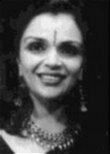 |
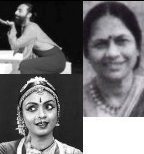 |
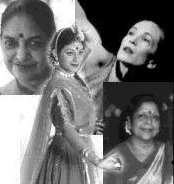 |
| The
Sri Krishna Gana Sabha is all spruced up for yet another season of dance
and music. Its special draw other than the dance programmes is the Natya
Kala Conference, which has now become truly global in nature bringing with
it a wealth of information and cross-cultural influences. The first day
of the 21st Natyakala Conference on December 15 is witness to a good gathering.
Anita Ratnam, convener for the second year in succession had made this conference an example in good management and use of creative elements for the purpose of education and experience. This year’s theme dealt with Choreography: The Art of Making Dances. “Choreography by itself is not recognized as a separate field which I feel is slowly becoming more and more specialized”, she said and added, “Given its evasiveness, choreography is often hard to think and talk about. Yet its place in serious debates cannot be ignored. It is the stuff of which dances are made of”. The basic issue we confront together as dancers, critics, scholars, historians, writers and choreographers is simple - is choreography an art form? Is it an evanescent form existing only in the bodies and personalities of the initial performer? Or does it like all other performing art forms have a substance, a compositional integrity that transcends the initial performance? Kumudhini Lakhia in her keynote address dwelt at length on the introduction of choreography into classical dance. She is one of the first Kathak dancers to visualize the dance form in its contemporary context. According to her a new approach of the known structures to suit new concepts is very essential. “It is safer to keep looking over your shoulder for material from the past rather than facing the vast, open plain before one. We must come out of this safe corner and have the courage to confront this thing called creation”. Through her long association with dance she has found that the most important thing for a dancer / choreographer was to keep the senses intact and alert. “It’s only when you have discovered the space around you in which you exist, that you can discover the space within you which is as infinite as the space outside. Sources are extremely important to choreography” she added, “there is an endless store of sources within all of us, we just have to know how to tap them”. Priyadarshini Govind set the deliberations of the conference on to a good start with her presentation ‘Bhava in Choreography’. Bhava cannot be the same in two people or even be the same in two consecutive performances. Bhava is the emotional and spiritual responses to external stimuli. And she decided to take her theme forward by dealing with padams, javalis and ashtapadis. There were questions whether bhava was in any way related to choreography. But there is a need to take into account the fact that in many ways Bharatanatayam has been a soloist delight. In that sense any exploration and developments leading to the awareness of creating and choreography in that area must be appreciated. |
 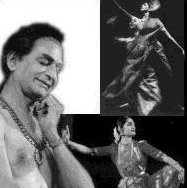 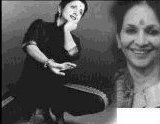  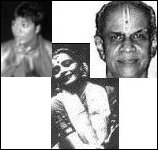 |
| Navtej
Johar who came next dealt with ‘Tradition and Individual Talent’. A
complete contrast to the first which was full of classicism and tradition,
Navtej wanted to show how much he loved Bharatanatyam – so he said movements
ranging from jumping to twirling constituted Bharatanatyam for him. “I
view dance as a medium that can usher us into new definitions of self”.
Navtej who is a Kalakshetra alumni also belongs to the Krishnamacharya
tradition of yoga and Vedic chanting and a practicing yoga therapist says,
“When we talk about choreography in Bharatanatyam it is not enough to deal
with technique alone. Focus on technique even though it is the more physical
aspect of dance form is what I feel has led to the erosion of physicality
in Bharatanatyam. I do not define physicality as athleticism but the body’s
ability to physically sustain a process of delving deeper and dealing with
and unlayering the repertoire within”.
Maya Rao, Madhu Natraj Heri and Ann Moradian were perfect examples of true confluence of ideas on December 16. Founder of the Natya Institute of Kathak and Choreography, Bangalore, Maya felt Kathak with its rich narrative content in gat bhav and abhinava aspects as well as the abstract in nritta had ample scope as resource material for choreography. In her lecture ‘Kathak as a Springboard for Choreography’, she drew upon the various salient features to enrich her creations. For example, one of the things she showed was the gat bhav in the nritya aspect where according to her a single dancer interprets stories to the accompaniment of the rhythm of a basic taal and a melody or a lehra played on a sarangi to indicate the basic rhythmic scale. Maya also finds interpretation of thumris and ghazals as a source of inspiration for choreography. She used a ghazal to show how it could be done. Her daughter and director of STEM (space, time, energy movement), Madhu Natraj has trained from Maya, Chitra Venugopal and Munna Shukla, folk and martial dances and studies the B.K.S Iyengar technique in yoga. For her, her association with Kathak seems inseparable from her existence as a dancer. “I do not belong to the school of thought that rejects tradition. To me traditional dance especially Kathak is a necessary part for the evolution of what can be called contemporary”. Ann Moradian is the artistic director and principal choreographer of Perspectives In Motion based in New York. “I find it rather interesting to talk about dance”, she said .All presentational dance according to her is abstract. She spoke about her own experiences when she began choreographing professionally (1982). Dance is not a universal language, because there are so many layers springing from context that one may not even recognize when one uses a sort of short hand which references a vast communal consciousness. What is clearly defined dance to one group of people may appear as pure abstraction to another. “I love many things about dancing. One of the things that I love about choreography is the empty space. That empty space which invokes not just an emotional empathetic, sympathetic experience of being but the full spectrum of our possibilities as sentient beings (mind, heart, body, soul) as much of our being as we can possibly engage. It is from here that we begin to enter the dance co-creating the work through the filter of our own experience and consciousness”. ‘Choreography of Adavus in Vazhuvoor Style’ by K.J Sarasa, one of the foremost disciples of Vazhvoor Ramaiah Pillai and having completed 52 years in the field of Bharatanatyam following Ann’s presentation seemed like the other end of the spectrum. A simple person with a lot of knowledge, she displayed her mastery over the art form – through the demonstration of the adavus and its various types, the korvais derived from a combination of adavus and the importance of the nadai, the karanas. Krishaveni Lakshmanan trained / guided by Rukmini Devi, Sharada Hoffman and S Sharada, was in fine form on December 17. She took up ‘Innovation in Group Choreography by Rukmini Devi’ who she said was a pioneer in the art of choreography. Rukmini Devi had choreographed about 25 dance dramas and those who worked closely with her could only admire her genius as a choreographer. She was the first person to make the accompanists sit at the right front corner of the stage. She started her innovation then and there itself. Her creativity continued in her dance dramas or group choreography and used the whole stage forming various patterns. Krishanveni gave examples of Rukmini Devi's work thorough a video presentation – excerpts from Meenakshi Vijayam where the use of martial arts was used for the first time, and scenes from the same of wedding sequences done uniquely for that time, scenes from the Ramayana etc. ‘Making Dance: A Choreological Approach’ by Preeti Athreya trained by the Dhananjayans, works with contemporary dancer Padmini Chettur. She spoke about the investigation into the practical theoretical study of dance for which dance specific methods are essential. The sources of these concepts are both the dance practice itself, which embodies concepts, and dance theoreticians. The choreological approach regards dance as an embodied art in which making, performing and appreciating with intention, impression and interpretation are seen as interdependent processes rather than distinct and separated roles and responsibilities. It was exciting to watch her on December 18 - because it was an incredible presentation - in conception and execution. It was Leela Samson, teacher, performer, and choreographer. And her ‘Spanda – Doing it as it Comes’ was truly an example of choreography in sounds, rhythms and in the exploration of the self within and from the space outside. Spanda as a group attempts to journey inwards seeking the essential center, the origin of movement and its source of strength. And that was demonstrated in the Spandamatrika, Charishnu where vibrations, pulse, lives expressed themselves. Music by O.S Arun was soulful and a wonderful foil for the creation on stage. ‘Rhythm as a Signifier’ by Prof C.V.Chandrasekhar and Manjari Rajendra Kumar, as discovered by the father daughter duo is about rhythm and its cycle. “We are surrounded by it, we live it and we breathe it”, said Manjari. Rhythm for dancers is more than just a beat. It has much wider range and scope and it goes beyond meter giving it a wider connotation. Each rhythm, she says, has its own inherent mood for which it is best suited; for instance the khandam is most suited for veera, raudra rasas and the tandava aspect. Similarly the mishram evokes sringara and bhakti. At the same time the same khandam and misram can completely change in their hues if the stress given on a particular beat changes. One of the foremost experimental theatre exponents of modern India, Veenapani Chawla has done theatre, acting and directing from 1979 and finally founded her own company Adishakti in 1984. She has worked on a project dealing with Koodiyattam, Nangiar Koothu and contemporary theatre and her presentation on December 19th dealt with ‘Choreography in Theatre’. There was a set of percussion instruments on stage with one of them being the recreated Pancha Mukha Vadyam used in the Guruvayur temple. This then set the mood for the demonstration of the use of rhythm, space and breath in choreography. Space, its arrangement in relation to the performer and inversely the arrangement of the performers’ behavior in relation to space to convey significance, is what choreography is all about. A demonstration of the use of percussion to show how rhythm and sounds could be used for koodiyattam followed. Mohiniattam by Usha Nangiar was very good and she showed how breath is used in the bhavas. How is choreography perceived, created and appreciated in Canada? This was Lata Pada’s tone of the presentation that followed Veenapani’s paper. While preserving the integrity of their dance styles in thematic content, technique and choreographic principles, some artists introduced modifications incorporating western theatrical and production values in lighting, set design and the like. For these artists the innovation was apparent in their use of choreographic space, re-interpretation of narratives, abstract and contemporary themes, costuming and the use of newly commissioned music. This led to new vistas in experimentation and inter-cultural works, examples of which were shown through a video presentation. She also showed excerpts from her autobiographical Revealed By Fire, which was rather moving. Self-indulgent or victim art? That was a matter for debate and only a question of perceptions! Ashish Mohan Khokar in his presentation ‘History of Choreography in Indian Dance’ traced the vast saga in a lighthearted fashion but with serious undertones. According to him choreography in Indian dance has also led to ‘chor’ graphy where each one is aping the other when not aping the west. He followed up with a video film that provided glimpses of dances by Astad Deboo, Daksha Seth, Birju Maharaj, and Geeta Chandran. Trained in Kathakali and Kathak, Astad Deboo has had his dance education in the west as well - the Martha Graham technique. And has created a dance theater style of his own. He has performed at the Great Wall of China, with Pink Floyd in London and at the 50th anniversary of the American Dance Festival. His collaborations with master puppeteer Dadi Pudumjee, theatre director Sunil Shanbag and presently with music composer Francis Silkstone make his work global. Many call him father of modern dance in India. Right now he works with the hearing impaired and he says working with them made them more confident, better performers, and learnt to project themselves better. It was a pensive Malavika Sarukkai on December 21 with her ‘Expanding Canvas’. Dance for her is a living, breathing art form. Bharatanatyam is a language - a powerful, evocative language – it provides her with a fundamental alphabet with which she choreographs her dance - both abstract and interpretative abhinaya. For her it is like the tree she described – the song of the tree and it was a process of getting closer in touch with herself. “We have to connect as people”, she concluded. Can a thillana evoke so much? Adyar K Lakshman just proved it through a Mohana Thillana with western orchestration. Originally composed by Madurai N Krishnan and the dance by Adyar K Lakshman, it had its modification by Thomas Navaratil from Vienna. This was followed by another, an Oothukadu Venkatasubbiah composition choreographed by L Narendra Kumar that was energy personified. Not completely traditional, it was an apt end to a fine conference. The best lec/dem award was given to Leela Samson. It is according to veteran dance-watcher VAK Ranga Rao who has been attending the Natya Kala Conference without fail since its inception in 1981 and who has been given the role of picking the best lec / dem since the beginning. At the end of it all, it was not the debates, not the opinions, not the trends that were important. It was the act of getting together cross cultural influences that almost always set patterns for future endeavors. All things start somewhere and in this case this transcended the smaller concerns to a wider canvas that is art - a living pulsating thing that shapes and influences lives and destinies. |